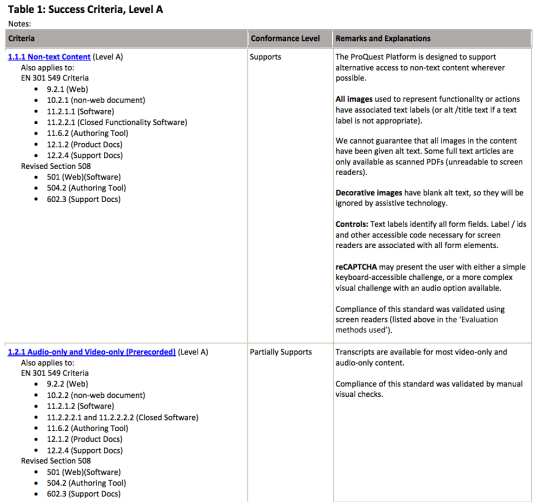How do I interpret a VPAT?
Section 508 of the Rehabilitation Act mandates that agencies procuring Information and Communications Technology (ICT) products consider accessibility of the product before making the purchase. Vendors are asked to use the Voluntary Product Accessibility Template (VPAT) to disclose the level of a product’s accessibility conformance, so that buyers can compare similar products and make informed purchasing decisions.
Reading and interpreting a VPAT can be challenging:
Don't Worry!
If you are making an ICT purchase for SSU, Information Technology will review the VPAT.
- They use the language of technical specifications.
- They refer to complicated US and European government codes and international accessibility guidelines.
- They list and describe accessibility principles that buyers may not be familiar with.
- Not all vendors are equally good at writing VPATs.
- There are different versions of the VPAT template, so older VPATs include different information than newer VPATs.
- There is no summary statement that says “Yes this is accessible!”
This document describes the parts of a VPAT, so reading and understanding them will be a little easier for SSU employees who purchase technology products.
Parts of a VPAT
Here is an example of a VPAT 2.x (PDF, 31 pages)
For information about VPAT 1.x, see below (link to anchor).
The VPAT includes several parts:
- A summary of VPAT product details
- Applicable Standards/Guidelines
- Accessibility Conformance Report (ACR) table(s)
- Some VPATs also include information and instructions for the vendors who fill out the VPAT, but this is usually omitted.
Summary
The summary briefly lists several general details about the product and VPAT.
- Product Name
- VPAT Date
- Contact information
- Evaluation Methods used
- Notes
- Some vendors might add additional details.
Here’s a screenshot from the VPAT for Microsoft Word.
Applicable Standards/Guidelines
This section indicates which standards and guidelines were used to develop the product. These will refer to Web Content Accessibility Guidelines (WCAG) 2.0, Section 508, and EN 301 549 (the European Union’s accessibility requirements).
Some vendors will also include WCAG 2.0 levels of conformance used when developing the product, as well. There are three levels of conformance: A, AA and AAA.
Note: This table does NOT summarize the overall accessibility of the product.
Here is a screenshot of the Applicable Standards/Guidelines section of the VPAT for Adobe Dreamweaver.
Accessibility Conformance Report (ACR)
The ACR is a table or series of tables listing each of the success criteria.
Usually, the ACR is organized by WCAG’s Principles, also known as POUR.
- Principle 1: Perceivable - Information and user interface components must be presentable to users in ways they can perceive.
- Principle 2: Operable - User interface components and navigation must be operable.
- Principle 3: Understandable - Information and the operation of user interface must be understandable.
- Principle 4: Robust - Content must be robust enough that it can be interpreted reliably by a wide variety of user agents, including assistive technologies.
The ACR has a table(s) comprised of three columns:
- Success Criteria - a brief title or description of each applicable WCAG 2.0 criterion, often with a link to the full text of the criterion on WCAG’s website. Sometimes the related Section 508 and EN 301 549 criteria will be listed in the same table cell, especially if the product is a combination of multiple types of ICT (e.g. electronic content, software, hardware, and support documentation and services) and/or the product is sold in Europe.
- Conformance Level - there are five standard levels of conformance.
- Supports: The functionality of the product has at least one method that meets the criterion without known defects or meets with equivalent facilitation.
- Supports with Exceptions: Some functionality of the product does not meet the criterion. Some vendors use the phrase “Partially Supports” instead of “Supports with Exceptions.”
- Does Not Support: The majority of product functionality does not meet the criterion.
- Not Applicable: The criterion is not relevant to the product.
- Not Evaluated: The product has not been evaluated against the criterion. This can be used only in WCAG 2.0 Level AAA
- Remarks and Explanations - this should be detailed remarks justifying a successful level, or explaining how the product does not meet the requirement.
Here is a sample screenshot of two rows from an ACR for a content repository product. This shows the response for WCAG criteria 1.1.1 Non-text Content, and 1.2.1 Audio-only and Video-only. You can view the same information in the product’s actual VPAT (PDF) here (scroll to page 3).
Notice that in the Remarks and Explanations column, the vendor has described where the success criterion applies (“all images used to represent functionality…”), and where it does not (images that have been uploaded by users to the content areas).
Older VPATs
Before Section 508 was updated in 2017 (knows as “Section 508 Refresh”), the VPAT had slightly different criterion, which were not closely associated with WCAG 2.0. Some vendors have not updated their VPATs to the newer version, so you may encounter VPATs that refer to the following technology categories, each with their own success criteria.
- 1194.21 - Software Applications and Operating Systems
- 1194.22 - Web-based Intranet and Internet Information and Applications
- 1194.23 - Telecommunications Products
- 1194.24 - Video or Multimedia Products
- 1194.25 - Self Contained, Closed Products
- 1194.26 - Desktop and Portable Computers
- 1194.31 - Functional Performance Criteria
- 1194.41 - Information, Documentation, and Support
Older VPATs still require the vendor to indicate the level of conformance for each Section 508 criteria, using the same conformance levels: Supports, Supports with Exceptions, Does Not Support, Not Applicable and Not Evaluated.




